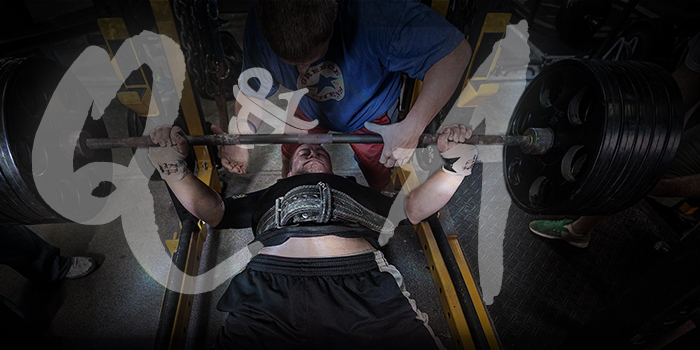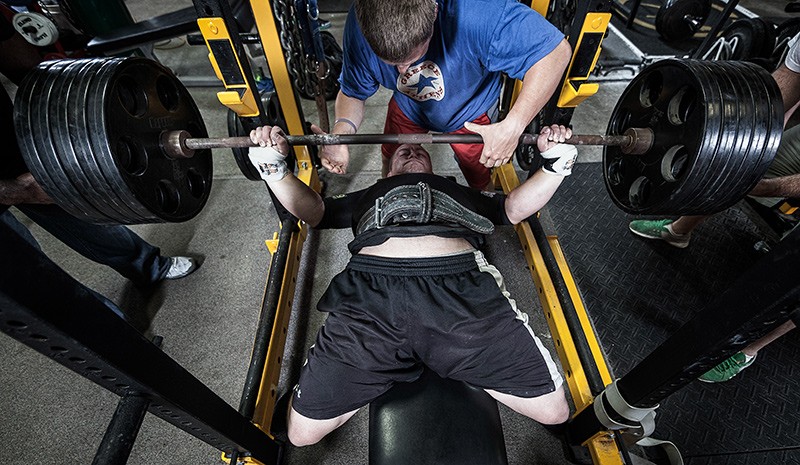
You have questions, team elitefts has answers. This article is a compilation of training questions asked by you, our readers, directly to the members of team elitefts. We previously covered multiple deadlifting topics and are today turning to the bench. Dave Kirschen, Brian Schwab, Brandon Smitley, Joey Smith, Swede Burns, and Thomas Deebel discuss shoulder position for the bench press and training around a torn pec.
RECENT: Deadlift Q&A: Block Pulls, Tension, Hip Mobility
Shoulders During the Bench Press
Jan Schumacher:
I'm really confused about shoulder positioning in the bench press. Currently I try to retract my shoulders blades back until the gap between the two shoulder blades is completely closed. After that, I try to depress the shoulder towards my backpocket as much as I can, without the shoulder coming out of its maximally retracted position. If I depress too much, the shoulders start to flare out again. So I keep my shoulders as depressed as I can with maximally retracted shoulder blades.
This results in thoracic extension and and a big upper back arch. During the movement I focus on bringing the chest toward the ceiling and try to avoid protracting forward or shrugging upward of the shoulders for the duration of the exercise. Is this the right way to set the shoulders? I've heard some coaches talk about shrugging the shoulders slightly or extremely toward the ears, using the lats in the bench by doing a lat spread which, in my case, would result in letting the shoulders out of its maximally retracted position or depressing the shoulders so much that the gap between the shoulder blades opens again.
I really don't find this Information on the net and there are no experienced powerlifters in my gym I can ask. In "So You Think You Can Bench" and "Bench Press 600 Pounds," Dave clarifies that you should retract your shoulders, but I can't find no explicit information on depressing, shrugging, or how much you should retract.
As a related question, should the shoulder positioning be different for raw or equipped lifter?
David Kirschen:
You might be overthinking this a bit. Rather than getting too deep into the biomechanics, try these simple cues.
First, retract the scapula (like you already are). Next, during the lift, especially the lowering, try to bend the bar into an upside-down "U," kind of like breaking a stick over your knee. During the press, imagine that rather than pushing the bar up, you are pressing your back into the bench against the weight. These cues have worked with just about every lifter I've worked with.
Also consider that your upper back musculature might not be strong enough to execute this all properly. If your goal is to improve your bench press, your upper back can NEVER be too strong. In fact, I've found that what generally separates good benchers from great ones is back strength, rather than triceps, shoulders, and triceps.
Brian Schwab:
The position you’re placing your scapula into bench is correct, down and back. This will help to elevate your chest while stabilizing your shoulder joint. Attempting to support your elbows against your lats may help provide some additional support, but flaring them, like you said, would compromise the position of your scapula.

The bar path is really the only thing that changes from raw to equipped. Your body position should stay the same. Keep doing what you’re doing, especially if it works for you. Everyone is different and may prefer different cues.
Brandon Smitley:
I think what you are doing is good. It would be awesome if you could post a video in here like you are doing.
Something I have lifters try is to lay on the bench like you are going to bench, but with a band in your hands like you are going to do a band pull apart. After you get set, perform a band pull apart. This is how the shoulders should be set during the whole movement. It sounds like you are doing everything correct, but to double check, you can give this a try. If this isn't what your back feels like when you bench press, you will immediately know.
And like Dave Kirschen said, breaking the bar does wonders. Really focus on squeezing those pinkies!
Joey Smith:
I think you should try and do what works for you. There are many options to setting up and how to bench. Everyone has options and what works for them. Take from each of those that work for you and create your way. This is a marathon not a sprint. Practice and try things and see what happens. Post a video too and let's see whats going on. Sometimes its the little things and sometimes those can be easy fixes.
Benching with a Torn Pec
George Anderson:
What technique would you use to bench press with a torn pec while minimizing the pecs for competition ?
Swede Burns:
I've had two pec tears. Depending on the severity of the tear, whether it's a belly tear or a tendon tear, the recovery time can be relatively short or a long process, even needing to be reattached in some cases.
In both cases I was lucky enough to not need surgery. The first thing you should do is see a doctor and determine how serious and what type of tear you have. In my case I was able to speed up the healing process I believe by doing some very light reverse band presses in a power rack a few times per week after the first two weeks, to get blood into the pecs. You mentioned competition in your question. I would not compete under any circumstances until the pec is 100%.
Thomas Deebel
I suffered a partial pec muscle tear and was lifting normal weights approximately eight weeks later. I had ART done on it and started to rehab the area with high reps three times per week adding weight slowly and decreasing the reps rom 30 at the bar to 175 x 15 at the end of the rehab. At that time I didn't have any pain and believed it was safe to increase the weight.









